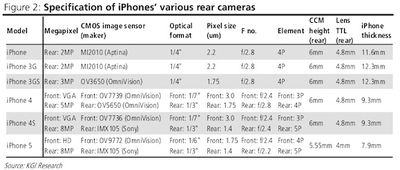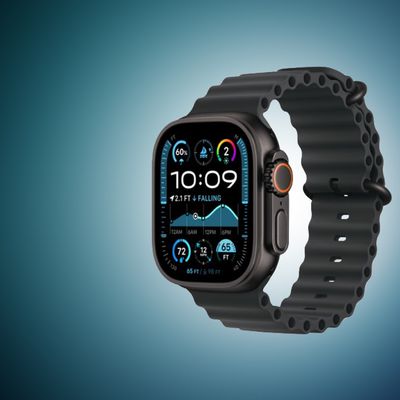Next-Generation iPhone Rumored to Adopt Thinner and Improved Front and Rear Cameras
In a new research note, KGI Securities analyst Ming-Chi Kuo reports that Apple will be making significant improvements to both front and rear cameras on the next-generation iPhone, advances driven by a desire to decrease the thickness of the device and to improve compatibility with a new 16:9 display.
According to Kuo, the rear camera on the iPhone will remain at 8 megapixels, but the aperture will be increased from f/2.4 to f/2.2 in order to reduce camera module height by nearly 0.5 mm.
[A] number of components have required a slim-down. The component that will undergo the most dramatic make-over is the rear camera. Our research shows that iPhone 5 will feature the first-ever slimmed rear camera of all iPhones, in an effort to deliver an ultra-slim iPhone 5.
Meanwhile, to enhance photography effects, iPhone 5’s rear camera will feature a larger f/2.2 aperture than iPhone 4S’s f/2.4. However, larger aperture means more noises. In addition, the reduced thickness means even greater challenges for lens design and assembly, as not only the lens, but also the voice coil motor (VCM) and CMOS image sensor (CIS) need to be slimmer. Finally, the compact camera module (CCM) suppler, responsible for the terminal assembly, will be confronted by assembly yield.

As for the front-facing camera, Kuo argues that Apple's move to a 16:9 display will drive a significant boost to HD quality for the front camera. HD offers the same 16:9 aspect ratio as the new display, as opposed to the 4:3 aspect ratio of the current VGA-quality FaceTime camera, and Apple will likely want to take full advantage of the device's new screen. In addition, moving the FaceTime camera to above the earpiece will allow for more centered images, improving the user experience.
The report also indicates that Apple is adopting flip-chip packing for the new front-facing camera, a process that will result in a thinner assembly and simplify lens production by moving the blue glass filter to the camera module itself.
Kuo has offered accurate information on a number of occasions in the past, relying on sources within Apple's supply chain to piece together Apple's product plans.
Popular Stories
Apple hasn't updated the AirPods Pro since 2022, and the earbuds are due for a refresh. We're counting on a new model this year, and we've seen several hints of new AirPods tucked away in Apple's code. Rumors suggest that Apple has some exciting new features planned that will make it worthwhile to upgrade to the latest model.
Subscribe to the MacRumors YouTube channel for more videos.
Heal...
Chase this week announced a series of new perks for its premium Sapphire Reserve credit card, and one of them is for a pair of Apple services.
Specifically, the credit card now offers complimentary annual subscriptions to Apple TV+ and Apple Music, a value of up to $250 per year.
If you are already paying for Apple TV+ and/or Apple Music directly through Apple, those subscriptions will...
Popular accessory maker Anker this month launched two separate recalls for its power banks, some of which may be a fire risk.
The first recall affects Anker PowerCore 10000 Power Banks sold between June 1, 2016 and December 31, 2022 in the United States. Anker says that these power banks have a "potential issue" with the battery inside, which can lead to overheating, melting of plastic...
In 2020, Apple added a digital car key feature to its Wallet app, allowing users to lock, unlock, and start a compatible vehicle with an iPhone or Apple Watch. The feature is currently offered by select automakers, including Audi, BMW, Hyundai, Kia, Genesis, Mercedes-Benz, Volvo, and a handful of others, and it is set to expand further.
During its WWDC 2025 keynote, Apple said that 13...
Apple's next-generation iPhone 17 Pro and iPhone 17 Pro Max are around three months away, and there are plenty of rumors about the devices.
Apple is expected to launch the iPhone 17, iPhone 17 Air, iPhone 17 Pro, and iPhone 17 Pro Max in September this year.
Below, we recap key changes rumored for the iPhone 17 Pro models:Aluminum frame: iPhone 17 Pro models are rumored to have an...
Apple last month announced the launch of CarPlay Ultra, the long-awaited next-generation version of its CarPlay software system for vehicles.
There was news this week about which automakers will and won't offer CarPlay Ultra, and we have provided an updated list below.
CarPlay Ultra is currently limited to newer Aston Martin vehicles in the U.S. and Canada. Fortunately, if you cannot...
Apple will finally deliver the Apple Watch Ultra 3 sometime this year, according to analyst Jeff Pu of GF Securities Hong Kong (via @jukanlosreve).
The analyst expects both the Apple Watch Series 11 and Apple Watch Ultra 3 to arrive this year (likely alongside the new iPhone 17 lineup, if previous launches are anything to go by), according to his latest product roadmap shared with...
Apple is planning to launch a low-cost MacBook powered by an iPhone chip, according to Apple analyst Ming-Chi Kuo.
In an article published on X, Kuo explained that the device will feature a 13-inch display and the A18 Pro chip, making it the first Mac powered by an iPhone chip. The A18 Pro chip debuted in the iPhone 16 Pro last year. To date, all Apple silicon Macs have contained M-series...
Apple is developing a MacBook with the A18 Pro chip, according to findings in backend code uncovered by MacRumors.
Earlier today, Apple analyst Ming-Chi Kuo reported that Apple is planning to launch a low-cost MacBook powered by an iPhone chip. The machine is expected to feature a 13-inch display, the A18 Pro chip, and color options that include silver, blue, pink, and yellow.
MacRumors...























